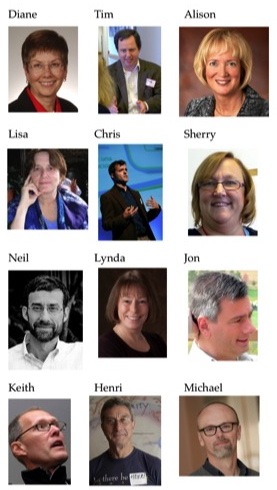Field Stories Overview
There are three ways to describe how Liberating Structures function and make a difference in the field. These include LS as:
- An Innovation Tool Chest
- Habits Which Reveal New Strategy
- Catalysts For A Movement
Each lens draws out different attributes of the Liberating Structures palette. For each lens, several stories illuminate how positive change has unfolded in the field.
1. Innovation Tool Chest: LS are seriously playful methods that help novices become expert contributors in any innovation effort. From the grass roots up and the fringe in, everyone can be included and unleashed. The wise crowd can outperform experts on very complex challenges. LS spark innovation and better-than-expected results by tapping new voices and local know-how. Stories from leaders who are innovating with LS include:
- Chris McCarthy boosts patient-centered design collaborations among US & UK health systems within the Innovation Learning Network in “Leaving Sight of Land to Invent the Future of Healthcare.”
- Dr. Diane Magrane guides medical school faculty and students, developing new competencies in “Academic Leadership from the Inside Out: Attending to Spiritual Needs.”
- Lisa Kimball introduces a more powerful approach to share on-the-ground knowledge for the US Army in “Army After-Action-Reviews in a Fishbowl.”
- Senator Lynda Moss includes diverse stakeholders in a way that enables new alcohol abuse legislation to pass in “Artful Passage of Montana Senate Bill 29”
- In analogous work, read Professor Zoran Popovic’s story “Novices Level Up to Expert Innovators with FoldIt.” Citizen scientists (aka computer gamers) solve complex puzzles in biology that have eluded experts.
 2. Habits that Reveal New Strategy: LS microstructures make it easy to shift everyday habits and interaction patterns in a way that the vast majority is included in shaping direction. Most change programs focus on developing strategies and values with the assumption that habits will follow. In our experience, knowing is not necessarily doing. LS focus on habits with the assumption that values and strategies will follow. The path forward is mutually shaped as planners and doers are reconnected. People act their way into new thinking. Leaders introducing new habits on-the-way-to-novel-strategies include:
2. Habits that Reveal New Strategy: LS microstructures make it easy to shift everyday habits and interaction patterns in a way that the vast majority is included in shaping direction. Most change programs focus on developing strategies and values with the assumption that habits will follow. In our experience, knowing is not necessarily doing. LS focus on habits with the assumption that values and strategies will follow. The path forward is mutually shaped as planners and doers are reconnected. People act their way into new thinking. Leaders introducing new habits on-the-way-to-novel-strategies include:
- Alison Joslyn in “Business Turnaround: From Lagging to Leading the Industry” shifts habits up-and-down herorganization, enabling a strikingly successful market strategy to take shape in Venezuela.
- Dr. Jon Velez, “Getting Out of the In-Formation IT Department,” shifts hospital IT culture by transcending and including top-down-command-and-control traditions.
- Tim Jassko-Fisher cultivates leadership for inter-professional collaboration in “Liberating the Courts and Child Welfare Law.” He is transforming a system that disappoints nearly all the players.
- Craig Yeatman boldly invites diverse members of a board and management team to shape next steps together on new product launches, investments, and strategic decisions in "Inclusive High-Stakes Decision Making Made Easy." He starts with a clear purpose and is willing to let go of overcontrol. NEW
3. Catalysts For a Movement: In contrast to managing a project, LS catalyze a broad movement. Leaders responsibly let go of over-control in a way that invites more local action and momentum. Leadership is more distributed: waiting for someone else or gaming the system is replaced by more freedom, self-organization, and mutual accountability. Guided by must-do and must-not-do principles (aka Min Specs), a movement spreads without central control. Leaders who responsibly let go and got better than expected results include:
- Dr. Michael Gardam leads an unconventional infection control research study across Canada, “Superbug Prevention Plus Enduring Culture Change.” The actions that help eliminate infections unfold from the ground up without direct supervision from leaders or experts. Small, local efforts generate a profound global impact.
- Consultant Neil McCarthy coaches a global corporation to coordinate IT engineering challenges in “Straight Up Business: You Are the Setter, Not the Spiker.” His approaches catch on via an informal grapevine.
- Nurse Sherry Belanger stages improv on hospital units, inspiring a student nurse to remind a powerful doctor to practice safely in “Marisa’s Rehearsal for Real Life As A Nurse.” Improv ignites social action, leveling the playing field to address safety challenges.
LS in Action. Photos by David Gasser and Keith McCandless
When LS become part of everyday use, elements of each lens come into play. Robust efforts feel more like a movement than a project. Innovations and new strategy emerge from the grass roots up as new voices are included and unleashed. With the imagination and resources at hand, much more is possible.
The 12 field stories are written by Keith McCandless. Innovating by Including and Unleashing Everyone is written by Keith McCandless and Henri Lipmanowicz.
